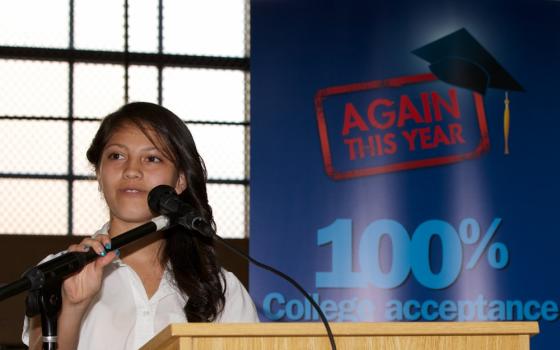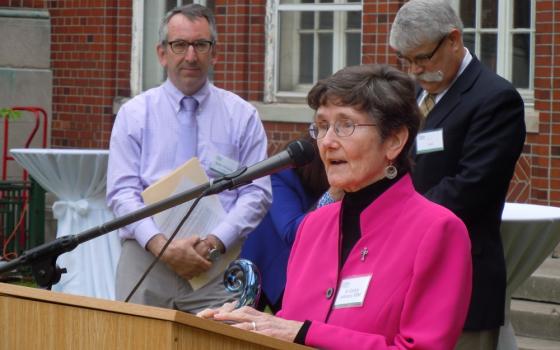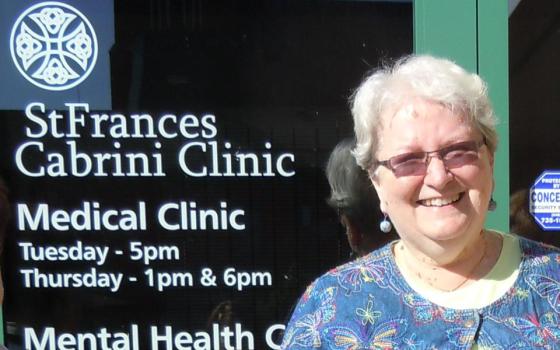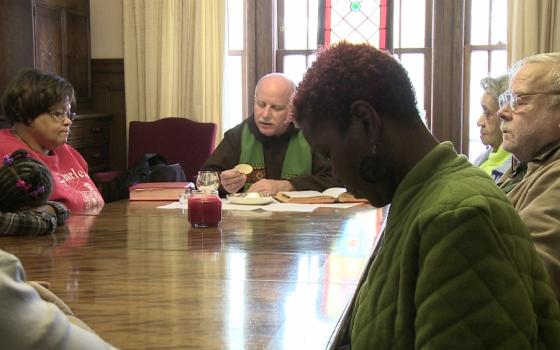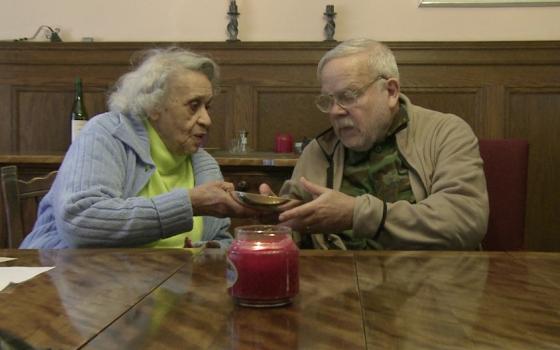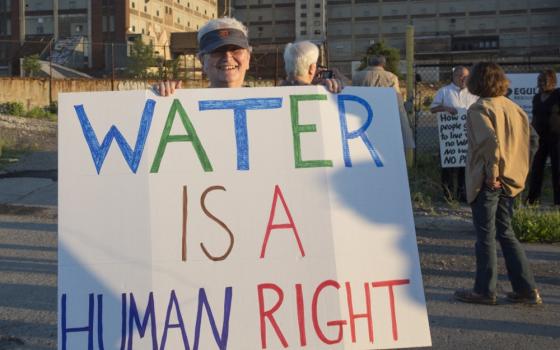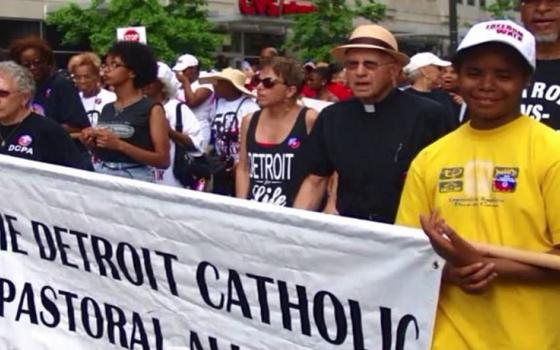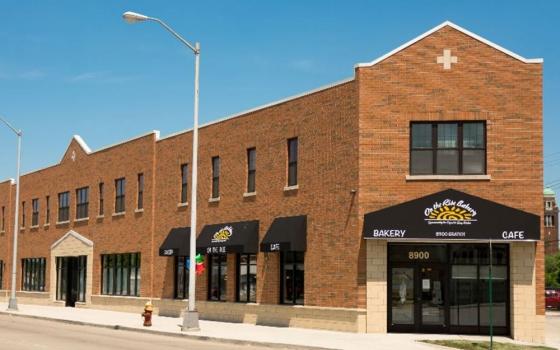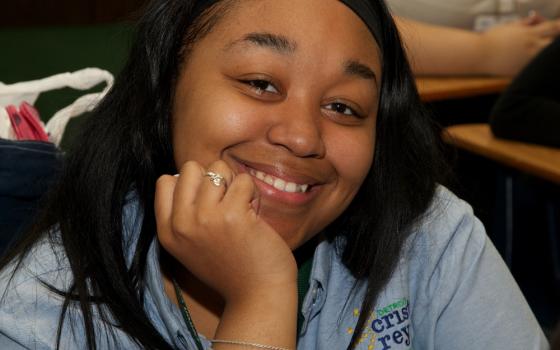Sr. MaryFran Barber grew up in Detroit during an era when the Catholic presence in the city was solidly evident. The Catholic archbishop still resided in the affluent neighborhood of Palmer Woods in a 13-bedroom mansion with a swooping drive and rooftop statue of the Archangel Gabriel fighting Satan. Catholic churches, some of the largest in the country, were the focal point of many neighborhoods, part of church compounds with their convent, school and rectory filling an entire city block.
In those days, a Catholic family could easily live cocooned within their own community. The kids could walk to the parish school; there were so many. You could get your hair cut at the barber shop owned by a fellow Catholic, swim in the Catholic swim club and buy your life insurance policy from a Catholic agent. “It was a ghetto!” recalled Barber, a Sister of the Immaculate Heart of Mary.
All that was before Detroit’s great dwindling, before the decades-long wheezing out of the automobile industry, before white flight that was followed by an exodus of the black middle-class, before the record-setting number of church closings in 1989 (the highest in U.S. church history, at the time), before the recession and housing crisis of 2008 that leached even more jobs and people from the city, before the declaration of bankruptcy – before Detroit, birthplace of the middle class, came to be regarded as a harbinger of post-industrial, urban America.
The ills that plague many American cities exist here in acute form: structural racism, joblessness, failing schools and a shrinking tax base, to name a few. In the 1950s, the city was 83 percent white and home to 1.9 million people. Today, it is 83 percent black, its population barely hovering above 700,000. That number is expected to decline despite the ambitious investment and development in midtown and downtown. Its residents, 38 percent of whom live in poverty, sporadically populate a territory larger than Boston, San Francisco and the borough of Manhattan combined.
Yet in this sprawling city where so many have pulled up stakes live women religious, firmly planted, articulating a Catholic presence in a place of drastic transitions. No longer in the convents of their youth, the women reside in modest efficiency apartments or small houses, enduring with their neighbors the vicissitudes of a habitat where crime and abandoned properties are givens and well-functioning municipal services are not.
None GSR spoke with expressed nostalgia for the Catholic enclaves of their past. Quite the opposite. Amid Detroit’s changing circumstances, these women have shown remarkable resiliency, adjusting their ministries to meet the needs of the city’s remaining inhabitants.
Former parish school teachers have become water rights activists, neighborhood developers and advocates for policies that include the disadvantaged in the city’s plans for re-design. Fiercely committed to Detroit, they say life in this post-industrial city has enriched and enlivened their faith. “I think I would die in the suburbs,” said Sr. of Mercy Mary Ellen Howard.
Investing in students
A self-described workaholic, Sr. of Mercy Canice Johnson is skilled at launching projects. Like many nuns, her resume includes years of teaching – in schools and college, as vocation director, and as facilitator of group processes.
In 1992, her community appointed her the first executive director of the Mercy Education Project, an effort focused on improving the education of low-income women and girls in Detroit. What began as a modest, after-school tutoring initiative has expanded into an organization that annually provides educational enrichment and job training to more than 250 women and girls.
Today, Johnson, 80, is best known as the woman who established a new Catholic high school in Detroit. An ordinarily heroic feat for nuns, who have a history of establishing schools, Johnson’s accomplishment is all the more impressive, because it was achieved in response to the Archdiocese of Detroit’s decision to close 15 schools, seven of which were high schools.
The closings, announced in the spring of 2005, left only two Catholic high schools in the Detroit area, both Jesuit-run institutions for boys. For Johnson, this was unacceptable.
While parents and teachers rallied in protest, Johnson worked with a group to create a new high school, sitting through discouraging meetings with church officials who, Johnson said, “thought we couldn’t do it.”
Detroit Cristo Rey, a co-ed Catholic high school, opened in the fall of 2008 in the formerly shuttered parish high school of Holy Redeemer Church. It was a small but concrete resurrection.
Sponsored by the Basilian Fathers and the Servants of the Immaculate Heart of Mary sisters, the new school is modeled after Cristo Rey programs in 17 states, in which students participate in work-study programs to help cover the cost of tuition while gaining employment experience.
The school in Detroit has graduated four classes so far and boasts a 100 percent college acceptance rate – an exceptionally impressive statistic for a city where, according to the Department of Education, 47 percent of the population over 16 is functionally illiterate.
Detroit Cristo Rey’s success is a bright chapter in the history of Catholic school leave-talking from Detroit. When asked about the 2005 closings, then Cardinal Adam Maida essentially said the schools had to go where the people were.
Johnson disagreed. She saw the needs and potential of her students, as well as “people’s sense that church officials had abandoned the city’s Catholic schools.”
“I just don’t think [church officials] were very creative,” Johnson said. “Our group truly believed it could be different.”
It was within days of the new school’s receiving multi-year funding from a local foundation that the donor called the archdiocese and was informed there would be no new Catholic schools in Detroit. The money was withdrawn, Johnson said, quickly noting that Maida later strongly supported the opening of Detroit Cristo Rey.
“I don’t think we will ever have the commitment to Catholic education [in Detroit] that we once had from the archdiocese and religious communities, at least not in terms of numbers of schools,” Johnson said. But she doesn’t believe Catholic schooling in Detroit is a finished story. New models need to be found.
An energizing faith
Johnson’s housemate is Sr. of Mercy Mary Ellen Howard, who said she thought she would die in the suburbs. The two nuns are a study in contrasts: Johnson is petite and deliberative, Howard robust and emphatic.
A former CEO of hospitals in Grayling and Muskegon, Mich., Howard chose to return to Detroit, her native city, after she turned 50. “The hospitals had become too much of a business,” Howard said. “I wanted to get back to my home, back to direct service, back to providing healthcare for the poor.”
For 19 years, she worked as executive director of the St. Frances Cabrini Clinic, a free health clinic for the poor and uninsured. The place flourished under her management. Once a small operation tucked in the wing of a parish elementary school, the clinic is now housed in a former convent. One hundred volunteer doctors, med students and pharmacists attend to the health needs of about 1,000 uninsured Detroiters.
The more the clinic expanded, the longer the line of people became outside the door, Howard said. “I realized we were never going to meet the needs of the 200,000 uninsured people in Detroit.” So she started advocating for healthcare reform at the municipal level. She sits on 10 boards of directors, and her role on each of them is the same: “I am there to raise the voice of the uninsured and influence their access to healthcare,” she said.
Johnson and Howard live on a forlorn-looking street in southeast Detroit. Abandoned properties are part of the landscape, as is the poverty. For a year, they washed the clothes of a family of squatters. One day, the squatters moved out and the scrappers moved in, stripping the house the family had occupied of all its valuable metal.
Yet for Howard, the Catholic presence in southeast Detroit is very much “alive and well.” Here live the Capuchins with their soup kitchen, urban farms and monastery, standing serene and vibrant amid the decay. The friars’ commitment to the impoverished eastside and nearby St. Charles Borromeo Church is sources of sustenance for the nun.
The parish school has closed and daily Mass is a luxury no longer available, but Howard, a regular in the gospel choir, has experienced an energizing faith among the hospitable parishioners who still worship here. The intimate, mid-week Mass, celebrated at the rectory’s dining room table, is one of the highlights of her week, she said.
Howard wonders where the poor across the city will go once 80,000 vacant properties are razed, as the mayor has promised, and development plans are completed. White-majority towns and suburbs surround Detroit, making its metropolitan area one of the most segregated in the country. “I’m not a historian, but there were government policies that encouraged this flight.”
Howard loves Detroit and its people. “I believe segregation is wrong, and the only way I can condemn that is with my body, by plopping myself in the middle of a black city,” she said.
The water fight
Earlier this year, Howard and Johnson joined the People’s Water Board Coalition, created in response to the city’s aggressive debt-reduction measure that shut off water for residences with overdue bills. According to Reuters, nearly 20,000 Detroiters lost access to water and sewer services this summer, sparking protests, an appeal to the United Nations and a class-action suit against the Detroit Water and Sewerage Department.
That these two sisters of Mercy entered the fray over Detroit’s water shut-offs is not surprising. Back in 2005, their order identified working for “the universal recognition of the fundamental right to water” as among their top five “critical concerns” of ministry. Howard who formally retired (she still volunteers) from Cabrini Clinic last April, said doctors there were always considering the social determinants influencing a patient’s health – lack of jobs, lack of transportation and, now, lack of water. Where you live, determines how long you live, a doctor once told her. “When I heard that, I thought, ‘Oh my God, I am dead!’” she said, laughing.
Arriving early at one of the water protests last summer, the two nuns were attired as if for a day hike in upstate Michigan, Johnson sporting an orange Detroit Tigers baseball cap and Howard a Tigers visor. Their smiling faces gave no evidence of the week’s hardships. Two of Howard’s close friends had died, and Johnson, who has stage-four lung cancer, had had another CAT scan.
When a young researcher from Columbia University asked for an interview, Howard, holding a placard that reads, “Water is a human right,” talked about the theft of democracy under Detroit’s emergency manager while Johnson chanted with the picketers nearby.
Later that morning Howard and eight other activists were jailed, charged with a misdemeanor and released on bail.
Then, as September came to a close and the city and its creditors moved closer to a settlement, the U.S. bankruptcy judge overseeing the Detroit proceedings ruled he would not block water shut-offs, saying there was no right to free water.
Maybe it is a movement back to the basics, Johnson earlier conceded, to go from teaching piano and English as she did in her youth to helping people obtain something as fundamental as water. The hardship in Detroit is the worst she has ever seen, and the solutions offered are harming rather than helping the poor.
But living in this dwindling city, Johnson said, has been mostly “an enrichment – of getting to know people and their situations and of coming to better understand Jesus’ approach to people.”
“It is a sense of wanting to be more like Jesus and less worried about acceptance by leaders in the church, of not being worried about pomp and circumstance [and wanting to] get back to where we are all alike . . . .” Johnson explained. “I wouldn’t want to go back. I would like to see people’s needs being met.”
Anchoring a neighborhood
The offices of the Detroit Catholic Pastoral Alliance are located on a wide avenue bordering the western edge of Gratiot Woods, a struggling neighborhood in southeast Detroit. Blocks away, abandoned houses, ransacked or burned, succumb to weeds and shrubs. A foam-core sign beside a gutted public school optimistically advertises, “Property for Sale.”
There is little evidence of this decay in the alliance’s spacious carpeted rooms, which are on the ground floor of a handsome brick building, fully occupied. Once a notorious after-hours joint, it is among a cluster of new and redeemed properties within the environs of the Nativity of Our Lord Catholic Church, a hub of vitality that Sr. Cathey DeSantis hopes will radiate deep into the community.
A teacher-turned-community developer, DeSantis is a Sister of St. Joseph and executive director of the alliance, a 600-member network of 13 parishes in metropolitan Detroit. She possesses a warrior’s commitment to Gratiot Woods, beating back the eroding forces of poverty, crime, an unstable housing market and, now, a city plan that zones the area as future farmland.
Over the past decade, the Detroit Catholic Pastoral Alliance has built 111 new housing units, renovated multiple commercial spaces, constructed community gardens and even installed 50 decorative lamp-posts.
The benefits of this revitalization are readily apparent to Dominican Sr. Jolene VanHandel, pastoral minister at the Nativity church. VanHandel, 75, has lived in Gratiot Woods since 1962, witnessing first-hand its seasons of stability, rapid decline and recent gradual redemption. She remembers when the Castle Grande building was “a nice apartment complex,” then abandoned and pillaged. The windows at street level were smashed, and people would drag their victims into the building and do terrible things, she said. Today, the building houses the 62-unit senior citizen center, fully occupied and with a waiting list.
“Since the Alliance came, we have seen a build-up in commercial activity. Many of our people feel more safe. Many of our old-time parishioners, who grew up here but have been away for years, are willing to come back.”
The alliance’s origins date to Detroit’s 1967 riot, or insurrection, as DeSantis calls it. The violence of that year marked “a pivotal moment in the modern trajectory of Detroit,” writes Scott Martelle in Detroit: A Biography. Forty-three people were killed – mostly young blacks shot by white police officers or Michigan National Guardsmen – more than 1,100 were injured and 7,000 arrested. In the wake of the turmoil, a group of priests began to meet to discern a Catholic response to a deeply ruptured city.
As white flight escalated, the group of priests grew to include women religious, pastoral associates and others engaged in ministries in the archdiocese. The alliance was at the forefront in opposing the parish closings of 1989.
Incorporated in 1990, the Detroit Catholic Pastoral Alliance’s mission is to “strengthen the quality of life in its communities by engaging members in the social, moral, political and economic issues” of the metropolitan Detroit area.
Development work in Gratiot Woods is the most substantial of their eight programs and has had to adjust over time to the changing tide in Detroit’s housing market. DeSantis said her group began by rehabbing the donated homes of white parishioners who had left the city; but single-family homes are a risky investment, so they switched to apartment units and more recently to commercial and mixed-use property.
All the new and redeemed properties lie within the immediate environs of the Nativity of Our Lord church, a deliberate construction strategy that DeSantis hopes to replicate in other struggling neighborhoods, if resources allow. It’s a familiar development model: church as a cornerstone upon which neighborhood resources are established. Only here, instead of school and convent, a nun and her organization bring affordable housing, small businesses to hire the city’s under-employed and even a small park for Detroit’s only urban 4-H club.
The alliance has built three market-rate apartments. All are occupied, proof that middle-income earners will reside in Gratiot Woods, she said. But even with this construction, the neighborhood remains a tenuous place in the eyes of the city’s planners – and perhaps some church officials. The numerous abandoned properties indicate a high vacancy rate. The drafters of the Detroit Future City project, the city’s current master plan, have zoned the area, and much of east Detroit, for agricultural production, complicating DeSantis’s ability to get funding for residential development.
For VanHandel, the need in Gratiot Woods is the very reason why the church should remain deeply present in the city.
“Our churches are the anchors of the neighborhood,” she said noting that Catholics from 34 of Detroit’s closed parishes attend Nativity. Its food pantry assists 400-500 people monthly. And it has enabled a neighborhood youth to attend Detroit Christo Rey.
“This,” said VanHandel, “is where Jesus would be.”
[Claire Schaeffer-Duffy is a longtime NCR contributor who lives and works at the Sts. Francis and Therese Catholic Worker Community in Worcester, Mass.]
